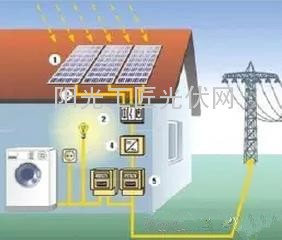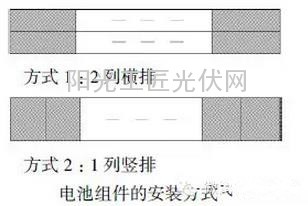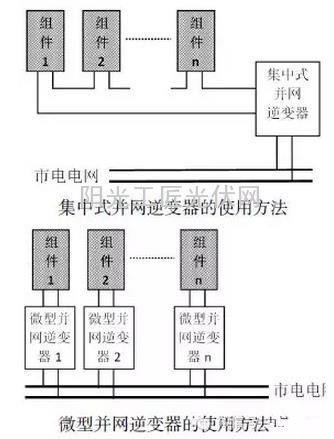The household photovoltaic system is shown in the figure below. It generally includes 1 battery module, 2 lightning protection boxes, 3 cables, 4 grid-connected inverters, and 5 metering instruments. But how to build a suitable type of photovoltaic grid-connected power generation system for the general public?

1. How to apply for building your own home photovoltaic system
State Grid promises that the State Grid will provide the whole process of access system planning, installation of energy metering devices, and acceptance and commissioning of grid-connected photovoltaic power generation projects without any fees; and supports distributed photovoltaic power generation with distributed access to low voltage. Distribution network, in accordance with national policies to purchase surplus power in full; free of spare capacity for all distributed photovoltaic power generation projects. The part of the project that is connected to the public power grid is also paid by the power grid. The user only needs to invest in the photovoltaic power generation equipment himself and put in a small amount of cable lines for his own use. So how do we apply?
In the first step, residents should preferably have independent venues (such as roofs) to install. If they are public rooftops, they must seek the consent of their neighbors.
In the second step, residents must seek permission from the industry committee or residents' committee of the self-built power station community.
In the third step, the residents went to the power company's business office to apply for the grid-connected photovoltaic power generation project. The power supply department will conduct on-site site surveys in the future and organize the review of the 380V (220V)-volt access plan.
In the fourth step, if there are problems with the design of access plans and equipment, the power supply department will provide access plans and access to the grid advice letter, and the residents will renovate the facilities according to the plan and opinion letter.
The fifth step is to install or find a professional company to install the grid-connected system.
In the sixth step, after the installation, the power company is notified to come and accept. They will install metering devices in the residents' homes, sign the ordering agreement, and complete the final grid connection procedure.
2. Design of solar power system capacity
The capacity is also the power generated by the photovoltaic power generation system and is generally designed based on the residents' building area. An area of ​​1 square meter can currently generate about 150W. The average resident can construct a 3kw-5kw power station, which also requires about 20m2 of installation space, and so on. The installation space can be a sloping roof or a flat roof.
3. The choice of solar modules
The battery assembly is divided into a single crystal silicon battery assembly, a polysilicon battery assembly, and an amorphous battery assembly. The single crystal has the highest power generation efficiency, and can emit more electricity in the same area. It is most suitable for single crystals with smaller mountable area, but the unit price will be higher. The efficiency of polysilicon is secondary, and polysilicon with a relatively affluent mounting area is more cost-effective. The lowest efficiency of amorphous silicon is generally not recommended. (Small knowledge: single crystal cells are generally rounded, polycrystalline cells are generally square)
The five parameters of the battery module are peak power, open circuit voltage, short circuit current, operating voltage, and operating current. The selection of these parameters is very important.
Battery packs are sized based on power, and single packs have power from 10W-300W. The single component power is proportional to the size and area, so choose the most suitable size of the battery components to meet your installation space requirements while selecting the power. For example, your 20m2 space is 2m*10m. You can choose the installation method as shown below.

The panel under sunlight (1000w/m2) 1 The voltage measured without load is the open circuit voltage, 2 The direct short circuit between the positive and negative poles of the battery module The measured current is the short-circuit current, 3 plus the load The measured voltage is the operating voltage and the measured current is the operating current. The operating voltage is generally proportional to the open circuit voltage, and the operating current is proportional to the short circuit current. The choice of these four parameters is very much related to the inverter to be selected later. In general, the open circuit voltage of grid-connected battery modules is generally about 45 volts, and the operating voltage is generally about 35 volts. Operating current and open circuit current vary with component power.
Series and parallel connection of battery modules: multiple battery modules can be used in series or in parallel, and can also be used in series and in parallel. For the grid-connected system, the series connection is to obtain the voltage suitable for the grid-connected inverter work, and the parallel connection is to increase the output power under the same voltage level.
4. Selection of grid-connected solar inverters
Grid-connected solar inverters are used as interface devices between photovoltaic modules and power grids. They convert DC power from photovoltaic cells into AC power and transmit them to grids. They play a crucial role in photovoltaic grid-connected power generation systems.
There are two kinds of grid-connected inverters for household use, one is a centralized grid-connected photovoltaic inverter with a minimum power of 1kw and an input voltage ranging from 150V to 550V. The other is a micro grid-connected photovoltaic inverter, generally used in the AC220V voltage level, power from 200W to 500W, the input voltage range is 12V ~ 28VDC. The usage of the two grid-connected inverters is very different, as shown in the figure below. Centralized grid-connected inverters are generally larger in size for wall-mounted installation. The miniature grid-connected photovoltaic inverters are compact and generally installed together with battery modules (which can be mounted on a bracket below the battery module). Both photovoltaic power generation systems can be selected.
The main parameters of the grid-connected inverter are the maximum input power, the maximum input voltage, the rated input voltage, the starting voltage, the MPPT voltage range, and the output grid voltage. The maximum input power is a limit value, and the peak power of the PV module is about 90% of this value; the maximum input voltage corresponds to the open circuit voltage of the battery module, and the open circuit voltage of the module array must be smaller than this value. The rated input voltage corresponds to the operating voltage of the PV module and can have a certain range of deviation. The starting voltage refers to the voltage point at which the grid-connected inverter is to start working. When the sunlight is too weak, the grid-connected inverter is not working. The MPPT voltage range is a function of the grid-connected inverter that is set for the characteristics of the battery board. It automatically adjusts the input voltage and current of the inverter so that the product of the voltage and current is the maximum power. The voltage range is very wide, and inverter panels with this function are more efficient; the output grid voltage refers to the voltage of the grid to be incorporated (single-phase 220V/three-phase 380V).

The main choice of the grid-connected inverter is to select the rated power and the input and output voltage levels. Then, the user can easily determine the input voltage range of the grid-connected inverter according to the voltage level and series-parallel connection of the battery module he has selected. According to the power condition of his own home, he can select single-phase or three-phase. Output. For example: the peak power of the panel is 200W, the open circuit voltage is 45V, and the operating voltage is 35V. To form a 2KW system requires 10 pieces of battery in series, the maximum input voltage of the grid-connected inverter must be greater than 45V/piece*10. Film = 450V, rated voltage is about 350V. The output voltage can be selected as single-phase 220V or three-phase 380V depending on the specific power supply of the home. Grid-connected inverters, as the most important part of the entire system, must choose products that have passed national certification (such as Golden Sun Certified CQC).
5. Selection of other components
1) Cable. Cables can be selected for photovoltaic dedicated cables, but the price is high, and less is also not good to buy. For short distances, BV cables are used, and the safety current of 1 square millimeter is calculated as 6A. For example, for a system with a power of 3 kw, for a photovoltaic input cable, the rated input voltage of the inverter is DC 350 V. Then, the current is 3000 W/350 V=8 ≈.57 A. The BV2.5 cable is selected. For the inverter output cable, the rated output voltage of the inverter is AC220V, then the current is 3000W/220V≈13.63A. Theoretically, the cable of BV2.5 can also be selected, but it can be improved by one grade for safety reasons. Select the BV4 cable.
2) Lightning protection device. Lightning arresters and common lightning arresters are not the same as the special high-voltage direct current lightning protection devices for photovoltaic applications. Because the continuous operating voltage of ordinary lightning protection devices is AC220V or AC380V, the continuous operating voltage of photovoltaic dedicated lightning protection devices can be up to DC1000V.
3) Metering The power company will install two meters for users free of charge, one is the meter for measuring the electricity generated by photovoltaic power generation, and the other is the two-way metering meter, which is the user's own electricity consumption and electricity metering meter to sell to the grid [2]. In this way, users can see their daily power usage, power generation status, and power status on the power grid.
6. Installation and commissioning
Installation If you are not familiar with the electrical system, it is best to have qualified personnel to install it. After the battery board is installed, the serial and parallel connection lines are preferably completed after the sun goes down, avoiding high voltage and electric shock, and at the same time doing lightning protection and grounding work. In addition, attention should be paid to the wind resistance rating of the bracket, and northern users should also pay attention to the anti-snow rating. Commissioning can be coordinated with the personnel of the power company.
Strain Gauges,Accuracy Load Cell,Parallel Grid Strain Gauge,Pressure Sensor Use Gauges
Zhejiang Nanhua Electronic Technology Co., Ltd , https://www.nhloadcells.com
